PALEOLITHIC ART MAGAZINE
EUROPA
IDOLATRY IN PALEOLITHIC AND POST-PALEOLITHIC ANTHROPOMORPHIC COLOSSUSES
Pietro Gaietto
For anthropomorphic colossuses we mean the sculptures representing human subjects larger than the real.( See photographs in bottom).
The photographs that I introduce concern the colossuses, for a short speech about the idolatry concerning the Paleolithic and the post-Paleolithic in Europe, Africa, Asia and America.
The speech on the idolatry is always extraneous to the books of art, but it is important to hold it in consideration, because it justifies the construction of great works of art, which have cost effort, and that were destined to a great number of persons.
About idolatry regarding the Paleolithic colossuses we cannot know anything, but we know from Pliny the Elder, and from other authors, that the colossuses among the Greeks and the Romans were very numerous, and that idolatry was the reason of their construction. It is presumed, therefore, that also in the Paleolithic existed the idolatry.
These are some citations by Pliny the Elder ( Naturalis Historia):
39. (18) - As to boldness of design, the examples are innumerable; for we see designed, statues of enormous bulk, known as colossal statues and equal to towers in size. Such, for instance, is the Apollo in the Capitol, which was brought by M. Lucullus from Apollonia, a city of Pontus,1 thirty cubits in height, and which cost five hundred talents
40. - Such, too, is the statue of Jupiter, in the Campus Martius, dedicated by the late Emperor Claudius, but which appears small in comparison from its vicinity to the Theatre of Pompeius: and such is that at Tarentum, forty cubits in height, and the work of Lysippus.2 It is a remarkable circumstance in this statue, that though, as it is stated, it is so nicely balanced as to be moveable by the hand, it has never been thrown down by a tempest. This indeed, the artist, it is said, has guarded against, by a column erected at a short distance from it, upon the side on which the violence of the wind required to be broken. On account, therefore, of its magnitude, and the great difficulty of moving it, Fabius Verrucosus3 did not touch it, when he transferred the Hercules from that place to the Capitol, where it now stands.
41. - But that which is by far the most worthy of our admiration, is the colossal statue of the Sun, which stood formerly at Rhodes, and was the work of Chares the Lindian, a pupil of the above - named Lysippus;4 no less than seventy cubits in height. This statue fifty - six years after it was erected, was thrown down by an earthquake; but even as it lies, it excites our wonder and admiration. Few men can clasp the thumb in their arms, and its fingers are larger than most statues. Where the limbs are broken asunder, vast caverns are seen yawning in the interior. Within it, too, are to be seen large masses of rock, by the weight of which the artist steadied it while erecting it. It is said that it was twelve years before this statue was completed, and that three hundred talents were expended upon it; a sum raised from the engines of warfare which had been abandoned by King Demetrius,6 when tired of the long-protracted siege of Rhodes.
42. - In the same city there are other colossal statues, one hundred in number; but though smaller than the one already mentioned, wherever erected, they would, any one of them, have ennobled the place. In addition to these, there are five colossal statues of the gods, which were made by Bryaxis
43. - Colossal statues used also to be made in Italy. At all events, we see the Tuscan Apollo, in the library of the Temple of Augustus,fifty feet in height from the toe; and it is a question whether it is more remarkable for the quality of the metal, or for the beauty of the workmanship. Spurius Carvilius also erected the statue of Jupiter which is seen in the Capitol, after he had conquered the Samnites, who fought in obedience to a most solemn oath; it being formed out of their breast-plates, greaves, and helmets, and of such large dimensions that it may be seen from the statue of Jupiter Latiaris. He made his own statue, which is at the feet of the other one, out of the filings of the metal.
44. - There are also, in the Capitol, two heads which are very much admired, and which were dedicated by the Consul P. Lentulus, one of them executed by the above-mentioned Chares, the other by Decius; but this last is so greatly excelled by the former, as to have all the appearance of being the work of one of the poorest of artists.
45. - But all these gigantic statues of this kind have been surpassed in our own age by that of Mercury, made by Zenodotus for the city of the Arverni in Gaul, which was ten years in being completed, and the making of which cost four hundred thousand sesterces. Having given sufficient proof there of his artistic skill, he was sent for by Nero to Rome, where he made a colossal statue intended to represent that prince, one hundred and ten feet in height. In consequence, however, of the public detestation of Nero's crimes, this statue was consecrated to the Sun.
Colossuses and idolatry are the union of a type of religion with a tradition of lithic sculpture among organized and rich peoples, independently from the fact that they were first hunters, and then farmers.
The peoples that have founded the first towns (in the territories of the current Egypt and Middle East) had enriched themselves with the agriculture, but their religion was connected to the idolatry, and their art to the sculpture. The painting, near these people, probably has been introduced by artists of the artistic-religious post-paleolithic Magdalenian Civilization of the Sahara, but it has had, almost exclusively, application in the decoration, and not in the representation of the divinities, which remained task of the sculpture.
The artistic-religious civilizations with lithic sculpture of the Paleolithic cross the various material cultures of the Mesolithic and the Neolithic, and reach the dawn of the history nearly everywhere. This passage, at least as far as the colossuses are concerned, can be studied on the menhirs of Carnac, the only locality in the world having grouped 2,730 of them in a limited space.
At Carnac the oldest menhirs are anthropomorphous, and are probably not less than 50,000 years old, while the most recent ones are simply hewn monoliths, and also of small size, certainly so made following a new religion; but the oldest and the most recent menhirs have in common the same place of worship, the same use of stone working, and the same way of aligning them. It is possible, at least here, to find a direct thread from the Paleolithic to the dawn of history, including the Mesolithic and Neolithic colossuses.

FIG. 1 Rock sculptures. They represent two big human heads. The head on the right has look forward, the head on the left is looking up. This group is called"the great couple of Tiglieto ".
Size: height beyond 5 m.
Location: Tiglieto, Genoa, Italy (under the road at the border with the Province of Savona). This photograph dates from 1969; currently the sculptures are covered by a pine wood.
Material Civilization: Mousterian or upper Paleolithc.
The man on the right seems followed by the other man. Perhaps they are male and female; in such a case, it could be the first paleolithic representation of the male and female couple, which has clear parallels in post-paleolithic religions. The shoulders are hinted at, as seen in the drawing.The represented human types have characters close to Homo sapiens neanderthalensis.
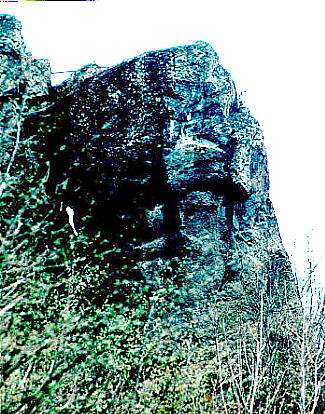
FIG. 2 Rock sculpture. It represents a gigantic human head in frontal view .
Size only of the face, and not of the cliff: Height 7 m approximately and widht 4 m. The cliff on the head could be a hat.
Location: Rocche di Borzone, Borzonasca, Genoa, Italy. (Altitude 500 m approximately).
Material culture: Mousterian or upper Paleolithc
The sculpture, from the valley dwellers, is called the "megalithic Face of Borzone ". It must be visited in winter, when the plants are without leaves. A study of this sculpture is published on Paleolithic Art Magazine: " The megalithic face of Borzone " , P. Gaietto, 2000.
(Photo by Pietro Gaietto)
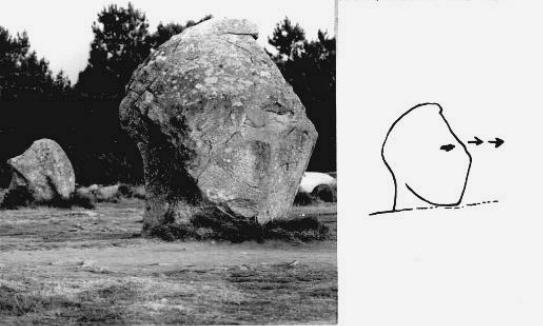
FIG. 3 Lithic Sculpture. (Menhir). It represents a human head with neck, hat or hairdo. The human type seems Homo sapiens neanderthalensis.
Size: beyond 5 m.
Location: Carnac, Brittany, France.
Material Civilization: Mousterian or upper Paleolithc.
It is one of the bigger sculptures at Carnac.
(Photo by Licia Filingeri)
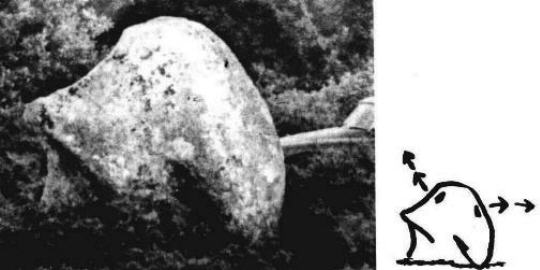
FIG. 4 Bicephalic anthropomorphic lithic sculpture (Menhir). It represents two human heads joined by the nape. In this sculpture of great dimensions, it is clearly seen that the stylistic deformation (extremely elegant), deliberately excludes the particulars of the face, i.e. eyes, nose, mouth, that the man, if he had wanted, would be able to do, as he has been able to elaborate a so harmonious shape.
The head (on the left) represents a Sapiens sapiens, and the head (on the right) a Sapiens neanderthalensis; however, this Neanderthalian with "
fat" face, remains one of the many unsolved problems.
Size: height 3.5 m approximately.
Location: Carnac, Brittany, France.
Material culture: Mousterian or upper Paleolithic.
(Photo by Licia Filingeri)
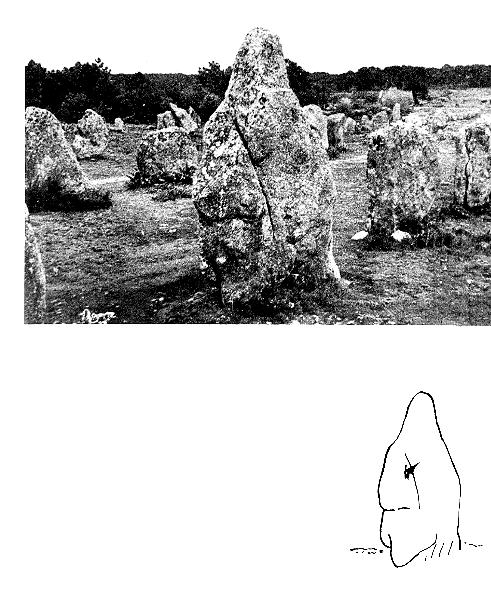
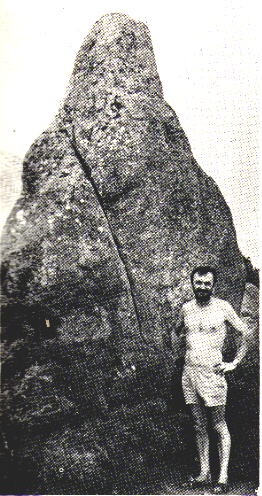
FIG. 5 Lithic Sculpture. (Menhir).It represents a human head with pointed hood.
Size: evident.
Location: Carnac, Brittany, France.
Material culture: Mousterian, perhaps upper Paleolithc.
In Brittany the menhir are 4,750. This zone has been place of cult from the Mousterian until the II millenium BC. At Carnac the menhirs are 2.730 and are aligned. The most ancient represent heads of Homo sapiens neanderthalensis, and for this we attribute them to the Mousterian, but also those that, like this, represent Homo sapiens sapiens, can be Mousterian, considering that the paleoanthropologists have established that Homo sapiens sapiens appeared before 80,000 years ago.
Currently, the only system of cultural attribution is the investigation through the represented human type, since there are no datings, because there are no "academic scholars" who deal with the problem of anthropomorphic menhirs. To do such research requires grants from the government, which only academic researchers can have. A menhir like this, if lifted, uncovers an intact site, which, at least through pollen, considering the progress made by science and technology, should provide sufficiently accurate datings.
(Photo by Licia Filingeri)

FIG. 6 EUROPE
Marble sculpture. Colossus.
It represents the head of Costantinus emperor.
Size: evident (from door and window).
Location: Rome, Italy.
Material culture: post-paleolithic Civilization.
(Photo 1934).
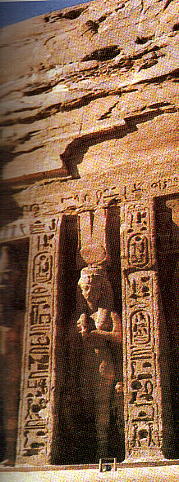
FIG. 7 AFRICA
Rock sculpture in the temple-cave. (Detail). Colossus.
It represents a deity with hat.
Size: height 10 m.
Location: Abu Simbel, Low-Nubia, Egypt.
XIX Dynasty.
Material culture: post-paleolithic Civilization.
The king Ramesses II at Abu Simbel erected another temple-cave with four high anthropomorhic colossal statues of sitting deities, 20 meters height.
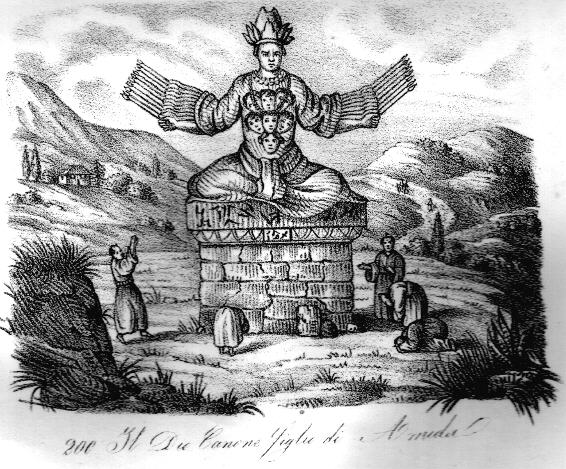
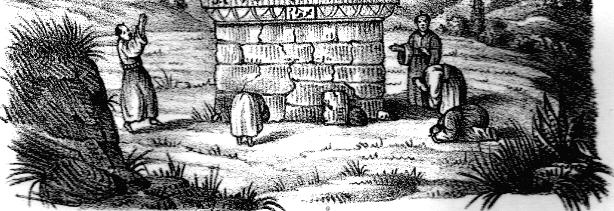
FIG. 8 ASIA
Anthropomorhic sculpture (gravure).
Colossus.
It represents the God Canone, son of Amida.
Size: evident.
Location: Japan.
The drawing is taken from the book: "Journey around the world", Venice, 1841, and also depicts five people, demonstrating how idolatry was being practiced.

FIG. 9 AUSTRALIA
Are not known lithic sculptures of colossuses, but not even lithic sculptures of small dimensions.
In Australia dominates the paleolithic and post-paleolithic magdalenian artistic-religious civilization, that, as known, does not have lithic sculpture.
The only form of sculpture (to my knowledge) is found in northern Australia. They are anthropomorphic and zoomorphic sculptures in wood, with modest dimensions, produced under the influence of the pearl fishermen of Makasan, that during the last three centuries landed on the northern Australian coast.
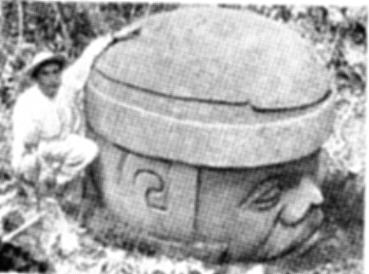
FIG. 10 AMERICA
Anthropomorhic lithic Sculpture. Colossus.
It represents a head with hat and without neck, carved in volcanic stone. It represents a God or, according to some reasearchers, the warrior kings, defending the coasts.
Size: evident.
Origin: Tuxtla (Mexico).
Photo E. Seler, before 1959.
Material culture: post-paleolithic Civilization. Olmeca Culture.
Dating: approximately 500 BC. - 200 AD.
I know other similar monolithic colossuses, found at S. Lorenzo Tenochtitlàn, Vera Cruz (Mexico): 7 are at the Anthropologic Museum in Xalapa (Mexico). It is a head 275 cn high, and without neck.
Index
HOME PAGE
Copyright©2000-2021 by Paleolithic Art Magazine, all rights reserved.












